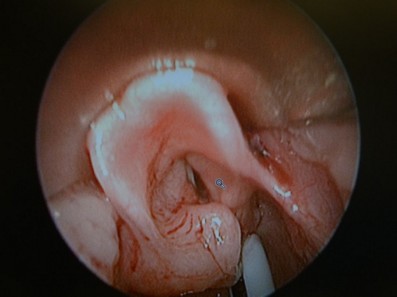[MIM 162 200, 162 210, 613 675]
(Neurofibromatosis type I)
Prevalence: 1/2,500 live births. Peripheral phakomatosis with multisystemic involvement with variable clinical expression and severity. Autosomal dominant transmission with variable penetrance of a mutation of gene NF1 on 17q11.2 but there is a high rate of de novo mutations (40-50%). This gene codes for neurofibromin: this protein is expressed in neurons, glial cells, melanocytes etc, and plays a role in the regulation of the RAS/MAPK pathway (ras-mitogen activated protein kinase pathway) that controls cell proliferation and development of tumors. In case of mutation, inactivation of the normal allele is also necessary to allow the production of tumors.
Clinical picture:
- cutaneous manifestations: cafe au lait spots (minimum 6, measuring more than 5 mm before puberty and 15 mm after puberty), lentigines (freckles resembling small spots) in the axillary and inguinal level (children and teens) (80%), cutaneous neurofibromas (often itchy nodules) which are small subcutaneous tumors following a nervous path, sometimes large infiltrating masses called plexiform neuromas
- iridial Lisch nodules (coloured iridial hamartoma detectable on slit lamp examination, in 85-90% of children over 10 years)
- extracutaneous neurologic manifestations: neurofibromas on the roots of spinal or autonomic nerves (50% develop in the head and neck regions), glioma of the optic chiasma, spinal cord tumors (Astrocytoma, ependymoma), macrocephaly, damage of cerebral arteries (Moyamoya);
- bone abnormalities: congenital pseudarthrosis of the tibia, scoliosis, dysplasia of the sphenoid;
- other conditions: arterial hypertension caused by stenosis of the renal artery or due to the presence of plexiform neurofibromas secreting catecholamines.
- tumors: Wilms, rhabdomyosarcoma, risk of pheochromocytoma.
- sometimes: short stature, precocious puberty

preglottic neurofibroma
|
Diagnotic criteria: At least two of the following must be present: 1. at least 6 cafe-au-lait spots > 5 mm in diameter before puberty, of > 15 mm in diameter after puberty 2. at least 2 neurofibromas or 1 plexiform neurofibroma 3. freckles in the axillary or inguinal regions 4. glioma of the optic nerve or the optic chiasma 5. at least 2 Lisch's nodules 6. specific primary osseous deficit: pseudarthrosis, sphenoid dysplasia, cortical thinning of the long bones 7. a first degree relative with NF1 |
Medical treatment: selumitinib (inhibitor of a MAPK kinase): it reduces the growth of neurofibromas. Risk of increased blood level of CPK (rhabdomyolysis), of cardiac or ocular toxicity.
Anesthetic implications:
difficult intubation in case of facial or oropharyngeal neurofibromas, careful attempts in case of neuraxial blocks. Risk of arterial hypertension. In case of kyphoscoliosis, the cervical spine stability should be checked with XRay.
References :
- Diaz JH.
Perioperative management of children with congenital phakomatoses.
Paediatr Anaesth 2000; 10:121-8. - Delgado JMS, Martin M.
Anaesthetic implications of von Recklinghausen's neurofibromatosis.
Paediatr Anaesth 2002; 12: 374 - Williams UU, Zavala AM, Van Meter A, Rebello E, Tan J, Owusu-Agyemang P.
Unanticipated compression of the trachea in a 5-month-old undergoing a MRI for evaluation of neurofibromatosis.
A&A Case Reports 2017; 8:1-3 - Gross AM, Wolters PL, Dombi E et al.
Selumetinib in children with inoperable plexiform neurofibromas.
N Engl J Med 2020;382:1430-42
Updated: May 2020